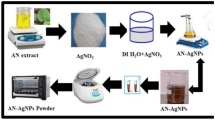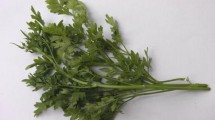Abstract
The use of natural plant extracts in the synthesis of nanoparticles provides advancement over chemical and physical methods, due to its cost effectiveness and environment friendly nature. In this study, silver nanoparticles (AgNPs) have been synthesized with simple and green technique using Pluchea sericea plant leaf extract as reducer as well as stabilizer. The characterization and properties of AgNPs were investigated using UV–visible spectroscopic techniques, energy dispersive X-ray spectrometers (EDS), zeta potential and dynamic light scattering. The UV–visible spectroscopic analysis showed the absorbance peak at 487 nm, which indicates the synthesis of silver nanoparticles. The experimental results showed silver nanoparticles having Z-average diameter of 59.20 nm with higher stability (−70.9 mV). The EDS analysis also exhibits presentation of silver element. Additionally, the different concentrations of AgNPs (25, 50, 75 and 100 %) showed antibacterial activity against Acinetobacter calcoaceticus. Finally, AgNPs from leaf extracts of P. sericea may be used for antimicrobial activity against A. calcoaceticus. However, further studies will be needed to fully understand the antimicrobial activity of AgNPs and to determine if the microorganism can develop resistance toward these nanoparticles.






Similar content being viewed by others
References
Ail-Catzim CE, García-López AM, Troncoso-Rojas R, González-Rodríguez RE, Sánchez-Segura Y (2015) Insecticidal and repellent effect of extract of Pluchea sericea (Nutt.) on adults Bemisia tabaci (Genn.). Revista Chapingo. Serie Horticultura 21:33–41
Azizi S, Namvar F, Mahdavi M, Ahmad M, Mohamad R (2013) Biosynthesis of silver nanoparticles using brown marine macroalga, Sargassum muticum aqueous extract. Materials 6:5942–5950
Baharara J, Namvar F, Ramezani T, Hosseini N, Mohamad R (2014) Green synthesis of silver nanoparticles using Achillea biebersteinii flower extract and its anti-angiogenic properties in the rat aortic ring model. Molecules 19:4624–4634
Bao Q, Zhang D, Qi P (2011) Synthesis and characterization of silver nanoparticle and graphene oxide nanosheet composites as a bactericidal agent for water disinfection. J Colloid Interface Sci 360:463–470
Danilcauk M, Lund A, Saldo J, Yamada H, Michalik J (2006) Conduction electron spin resonance of small silver particles. Spectrochim Acta Part A Mol Biomol Spectrosc 63:189–191
Dhand V, Soumya L, Bharadwaj S, Chakra S, Bhatt D, Sreedhar B (2016) Green synthesis of silver nanoparticles using Coffea arabica seed extract and its antibacterial activity. Mater Sci Eng C 58:36–43
Dijkshoorn L, Nemec A, Seifert H (2007) An increasing threat in hospitals: multidrug-resistant Acinetobacter baumannii. Nature Rev Microbiol 5:939–951
Duman O, Tunç S (2009) Electrokinetic and rheological properties of Na-bentonite in some electrolyte solutions. Micropor Mesopor Mater 117:331–338
Jebakumar IET, Sethuraman MG (2012) Instant green synthesis of silver nanoparticles using Terminalia chebula fruit extract and evaluation of their catalytic activity on reduction of methylene blue. Process Biochem 47:1351–1357
Ji-Ho P, Luo G, Geoffrey M, Michael JS (2009) Biodegradable luminescent porous silicon nanoparticles for in vivo applications. Nat Mater 8:331–336
Jyoti K, Baunthiyal M, Singh A (2015) Characterization of silver nanoparticles synthesized using Urtica dioica Linn. leaves and their synergistic effects with antibiotics. J Radiat Res Appl Sci. doi:10.1016/j.jrras.2015.10.002
Kalaiarasi R, Prasannaraja G, Venkatachalama P (2013) A rapid biological synthesis of silver nanoparticles using leaf broth of Rauvolfia tetraphylla and their promising antibacterial. Indo Am J Pharm Res 3:8052–8062
Kaushik N, Thakkar S, Mhatre RY, Parikh MS (2010) Biological synthesis of metallic nanoparticles. Nanomed Nanotechnol Biol Med 6:257–262
Kim J, Yu K, Kim J, Park S, Lee H, Kim S, Park Y, Hwang C, Kim Y, Lee Y, Jeong D, Cho M (2007) Antimicrobial effects of silver nanoparticle. Nanomedicine 3:95–101
Matei A, Cernica I, Cadar O, Roman C, Schiopu V (2008) Synthesis and characterization of ZnO-polymer nanocomposites. IntJ Mater Form 1:767–770
Muthukrishnana S, Bhakya S, Kumar T, Rao MV (2015) Biosynthesis, characterization and antibacterial effect of plant-mediated silver nanoparticles using Ceropegia thwaitesii an endemic species. Ind Crops Prod 63:119–124
Parashar UK, Kumar V, Bera T, Saxena PS, Nath G, Srivastava SK, Giri R, Srivastava A (2011) Study of mechanism of enhanced antibacterial activity by green synthesis of silver nanoparticles. Nanotechnology 22:415104
Prathna TC, Raichur AM, Chandrasekaran N, Mukherjee A (2011) Biomimetic synthesis of silver nanoparticles by Citrus limon (lemon) aqueous extract and theoretical prediction of particle size. Colloids Surf B Biointerfaces 82:152–159
Ramalingam V, Rajaram R, Premkumar C, Santhanam C, Dhinesh P, Vinothkumar S, Kaleshkumar K (2013) Biosynthesis of silver nanoparticles from deep sea bacterium Pseudomonas aeruginosa JQ989348 for antimicrobial, antibioflim and cytotoxic activity. J Basic Microbiol 53:1–9
Raveendran P, Fu J, Wallen SL (2003) Completely green synthesis and stabilization of metal nanoparticles. J Am Chem Soc 125:13940–13941
Saxena A, Tripathi RM, Singh RP (2010) Biological synthesis of silver nanoparticles by using onion (Allium cepa) extract and their antibacterial activity. Dig J Nanomater Biostruct 5:427–432
SAS Institute (1997) SAS/STAT User’s Guide. Release 6.03 edn. Cary, NC, USA
Sharma V, Yangard R (2009) Green synthesis and their antimicrobial activities. J Colloid Interface Sci 9:83–96
Sharma G, Jasuja ND, Rajgovind PS, Joshi SC (2014) Synthesis, characterization and antimicrobial activity of Abelia Grandiflora assisted AgNPs. J Microbial Biochem Technol 6:274–278
Singh A, Jain D, Upadhyay MK, Khandelwal N, Verma HN (2010) Green synthesis of silver nanoparticles using Argemone mexicana leaf extract and evaluation of their antimicrobial activities. Dig J Nanomater Biostruct 5:483–489
Sivalingam P, Antony JJ, Siva D, Achiraman S, Anbarasu K (2012) Mangrove Streptomyces sp. BDUKAS10 as nanofactory for fabrication of bactericidal silver nanoparticles. Colloids Surf B Biointerfaces 98:12–17
Umoren SA, Obot IB, Gasem ZM (2014) Green synthesis and characterization of silver nanoparticles using red apple (Malus domestica) fruit extract at room temperature. J Mater Environ Sci 5:907–914
Van Looveren M, Goossens H (2004) Antimicrobial resistance of Acinetobacter spp. in Europe. Clin Microbiol Infect 10:684–704
Villaseñor JL, Villareal JA (2006) El género Pluchea (Familia: Asteraceae, Tribu: Plucheeae) en México. Revista Mexicana de Biodiversidad 77:59–65
Vishal RP, Agrawal YK (2011) Nanosuspension: an approach to enhance solubility of drugs. J Adv Pharm Technol Res 2:81–87
Yang D, Cui D (2008) Advances and prospects of gold nanorods. Chem Asian J 3:2010–2022
Yıldız U, Ibtisam ET (2010) Development of a sensitive detection method of cancer biomarkers in human serum (75%) using a quartz crystal microbalance sensor and nanoparticles amplification system. Talanta 82:277–282
Author information
Authors and Affiliations
Corresponding author
Rights and permissions
About this article
Cite this article
Abdelmoteleb, A., Valdez-Salas, B., Carrillo-Beltran, M. et al. Green Synthesis of Silver Nanoparticles Using Pluchea sericea a Native Plants from Baja California, Mexico and their Potential Application as Antimicrobials. Iran J Sci Technol Trans Sci 42, 457–463 (2018). https://doi.org/10.1007/s40995-016-0019-6
Received:
Accepted:
Published:
Issue Date:
DOI: https://doi.org/10.1007/s40995-016-0019-6




